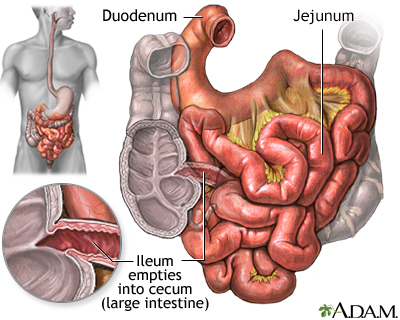Upper GI and small bowel series
GI series; Barium swallow x-ray; Upper GI series; Small bowel follow through
An upper GI and small bowel series is a set of x-rays taken to examine the esophagus, stomach, and small intestine.
Barium enema is a different test that examines the large intestine.

An upper GI series is performed to examine the esophagus, stomach, and small intestine. The purpose of the test is to detect abnormalities in those areas.

An upper GI series in a patient with cancer of the stomach (gastric carcinoma).

This is an example of a procedure called an upper GI series. The person swallows a substance called barium which allows for illumination of the organs in question. In this case, an ulceration is present in the stomach, seen on the right of the screen. This method is a means of diagnosing stomach ulcers as well as other anomalies along the upper gastrointestinal tract.

A GI series in a patient with a twisted bowel (volvulus).

The small intestine is the portion of the digestive system most responsible for absorption of nutrients from food into the bloodstream. The pyloric sphincter governs the passage of partly digested food from the stomach into the duodenum. This short first portion of the small intestine is followed by the jejunum and the ileum. The ileocecal valve of the ileum passes digested material into the large intestine.
How the Test is Performed
An upper GI and small bowel series is done in a radiology department.
You may get an injection of a medicine that slows muscle movement in the small intestine. This makes it easier to see the structures of your organs on the x-rays.
Before the x-rays are taken, you must drink 16 to 20 ounces (480 to 600 milliliters) of a milkshake-like drink. The drink contains a substance called barium, which shows up well on x-rays.
An x-ray method called fluoroscopy tracks how the barium moves through your esophagus, stomach, and small intestine. Pictures are taken while you sit or stand in different positions.
The test most often takes around 3 hours but can take as long as 6 hours to complete.
A GI series may include this test or a barium enema.
How to Prepare for the Test
You may have to change your diet for 2 or 3 days before the test. In most cases, you will not be able to eat for a period of time before the test.
Be sure to ask your health care provider if you need to change how you take any of your medicines. Often you can continue taking the medicines you take by mouth. Never make any changes in your medicines without first talking to your provider.
You will be asked to remove all jewelry on your neck, chest, or abdomen before the test.
How the Test will Feel
This test may cause mild bloating but no discomfort most of the time. The barium milkshake feels chalky as you drink it.
Why the Test is Performed
This test is done to look for a problem in the structure or function of your esophagus, stomach, or small intestine.
Normal Results
A normal result shows that the esophagus, stomach, and small intestine are normal in size, shape, and movement.
A normal result may vary depending on your overall health. Talk to your provider about the meaning of your specific test results.
What Abnormal Results Mean
Abnormal results in the esophagus may indicate the following problems:
Abnormal results in the stomach may indicate the following problems:
- Gastric cancer
- Gastric ulcer - benign
- Gastritis
- Polyps (a tumor that is usually noncancerous and grows on the mucus membrane)
- Pyloric stenosis (narrowing)
Abnormal results in the small intestine may indicate the following problems:
- Diverticulosis
- Malabsorption syndrome
- Narrowing (stricture)
- Swelling and irritation (inflammation) of the small intestines
- Tumors
- Ulcers
The test may also be done for the following conditions:
Risks
You are exposed to a low level of radiation during this test, which carries a very small risk for cancer. X-rays are monitored and regulated to provide the minimum amount of radiation exposure needed to produce the image. Most experts feel that the risk is low compared with the benefits.
Pregnant women should not have this test in most cases. Children are more sensitive to the risks for x-rays.
Barium may cause constipation. Talk to your provider if the barium has not passed through your system by 2 or 3 days after the exam.
Considerations
After this test, the barium that remains in the body may block details in other imaging tests. For this reason, other imaging tests may be done first.
References
Agosto O, Dass C, Caroline DF. The stomach. In: Adam A, Dixon AK, Gillard JH, Schaefer-Prokop CM, eds. Grainger & Allison's Diagnostic Radiology. 7th ed. Philadelphia, PA: Elsevier; 2021:chap 20.
Al Sarraf AA, McLaughlin PD, Maher MM. The small intestine, mesentery and peritoneal cavity. In: Adam A, Dixon AK, Gillard JH, Schaefer-Prokop CM, eds. Grainger & Allison's Diagnostic Radiology. 7th ed. Philadelphia, PA: Elsevier; 2021:chap 21.
Carucci LR. Diagnostic imaging procedures in gastroenterology. In: Goldman L, Cooney KA, eds. Goldman-Cecil Medicine. 27th ed. Philadelphia, PA: Elsevier; 2024:chap 119.
Version Info
Last reviewed on: 10/30/2024
Reviewed by: Jenifer K. Lehrer, MD, Gastroenterologist, Philadelphia, PA. Review provided by VeriMed Healthcare Network. Also reviewed by David C. Dugdale, MD, Medical Director, Brenda Conaway, Editorial Director, and the A.D.A.M. Editorial team.
